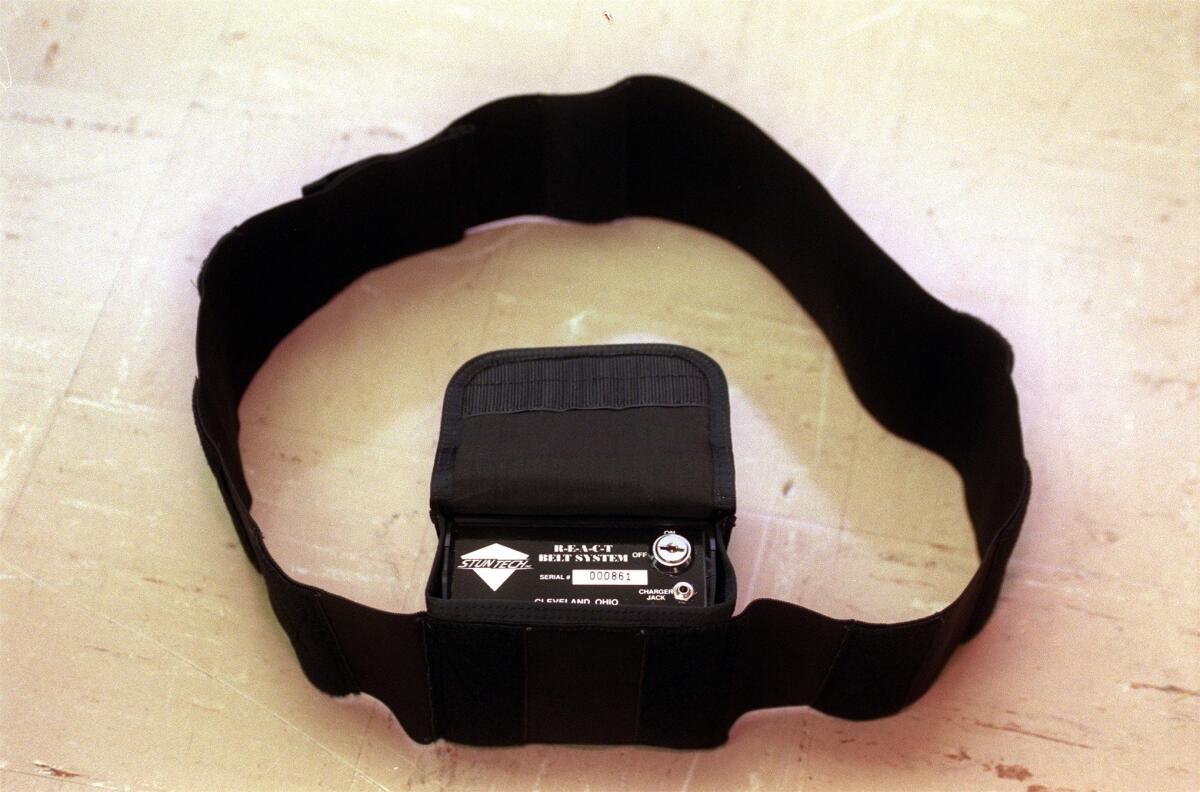Death penalty upheld for defendant forced to wear stun belt

- Share via
SAN FRANCISCO — The California Supreme Court upheld a death sentence Monday for a man who was forced to wear a stun belt during his trial, rejecting arguments that the prospect of being electrically shocked adversely affected his demeanor before jurors.
In a 6-1 decision, the majority noted that the prosecution had conceded the court erred in requiring the stun belt, but the justices concluded that it did not affect the outcome of the trial.
The ruling came in an appeal by Jonathan Keith Jackson, who was convicted of murdering Monique Cleveland during an attempted drug-related robbery in Riverside County in 1996 and attempting to murder her husband, Robert.
Jackson argued that he had been improperly forced to wear the stun belt during his trial. Stun belts, designed to control troublesome defendants with an eight-second, 50,000-volt electric shock, are operated remotely by a law enforcement officer.
The shock knocks the wearer to the ground, causes intense writhing and shaking, and may result in uncontrolled defecation and urination as well as serious medical injury, the court said in a 2002 ruling that severely restricted their use.
There was no evidence that jurors knew Jackson was wearing a stun belt. It was underneath his clothing.
But Justice Goodwin Liu said the fear of being shocked may affect a defendant’s demeanor, which can be critical to jurors considering whether to recommend life without parole or the death penalty.
The belt can activate accidentally, and Jackson had feared setting it off, according to the court.
“Most people, with such a device strapped around the waist, would sit as still and impassively as they possibly could in order to avoid activating it. (I would hesitate to even sneeze.),” Liu wrote.
Jackson’s impassive demeanor might have contributed to the jury’s decision to recommend death, Liu wrote. The role played by the belt was particularly important because Jackson’s sentence was a close question, Liu said. A previous jury had deadlocked on whether to recommend the death penalty.
Justice Marvin R. Baxter, writing for the majority, called Liu’s contentions “highly dubious” speculation.
“There is no indication the belt caused defendant mental anxiety or inhibited his ability to confer with counsel and participate in his defense,” Baxter wrote. “There is, however, evidence that defense counsel viewed defendant’s demeanor as weighing in his favor during the penalty trial.”
Baxter said that Jackson’s claim of being affected psychologically by the belt was “inconsistent with his complete failure to mention the stun belt or its effects in any of his various motions for a mistrial, a new guilt trial, and a new penalty trial.”
Jackson was tried before the 2002 state high court ruling that set stiff requirements before defendants could be forced to wear the belts. But the restrictions that ruling required still apply to Jackson, Liu said, calling Monday’s decision “a retreat from the rigorous standards governing the use of stun belts and similar devices.”
Liu joined the rest of the court in affirming the guilty verdict, concluding that Jackson’s demeanor during the trial’s guilt phase “was not relevant to the jury’s determination of the objective facts comprising his crimes.”
But during the penalty phase, jurors may put more weight on how defendants present themselves and react to testimony, Liu said. He noted that a judge had described Jackson as appearing emotionless.
“It is hardly unreasonable to think that lack of emotion may be one effect of being forced to wear an electric shock device that is susceptible to accidental activation and designed to achieve ‘total psychological supremacy’ through the threat of ‘debilitating pain,’ ” Liu wrote, quoting from the court’s 2002 ruling.
“The prejudice can be acute during the sentencing phase of the proceedings, when the sentencer must attempt to know the heart and mind of the offender and judge his character, his contrition or its absence, and his future dangerousness,” Liu said.
Liu also argued that the majority had failed to apply the appropriate legal test in deciding whether the error of imposing the belt was harmless. Defense lawyers have long complained that the court excessively determines errors to be harmless in dispatching death penalty cases.
More to Read
Sign up for Essential California
The most important California stories and recommendations in your inbox every morning.
You may occasionally receive promotional content from the Los Angeles Times.














